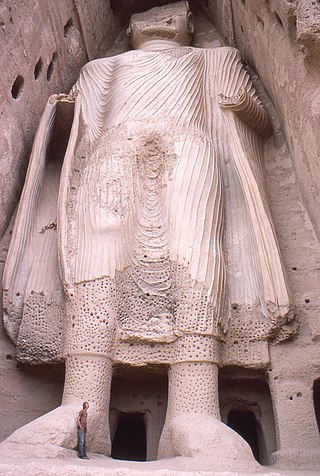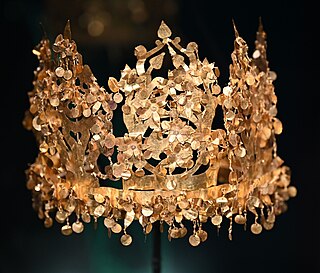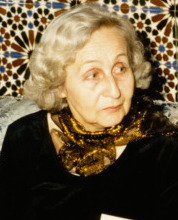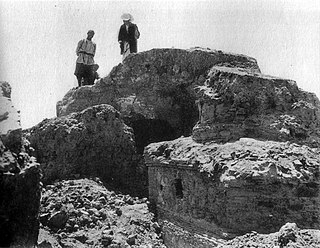
The ancient history of Afghanistan, also referred to as the pre-Islamic period of Afghanistan, dates back to the prehistoric era and the Helmand civilization around 3300–2350 BCE. Archaeological exploration began in Afghanistan in earnest after World War II and proceeded until the late 1970s during the Soviet–Afghan War. Archaeologists and historians suggest that humans were living in Afghanistan at least 50,000 years ago, and that farming communities of the region were among the earliest in the world. Urbanized culture has existed in the land from between 3000 and 2000 BC. Artifacts typical of the Paleolithic, Mesolithic, Neolithic, Bronze, and Iron ages have been found inside Afghanistan.

The Buddhas of Bamiyan were two 6th-century monumental Buddhist statues in the Bamiyan Valley of Afghanistan. Located 130 kilometres (81 mi) to the northwest of Kabul, at an elevation of 2,500 metres (8,200 ft), carbon dating of the structural components of the Buddhas has determined that the smaller 38 m (125 ft) "Eastern Buddha" was built around 570 CE, and the larger 55 m (180 ft) "Western Buddha" was built around 618 CE, which would date both to the time when the Hephthalites ruled the region. As a UNESCO World Heritage Site of historical Afghan Buddhism, it was a holy site for Buddhists on the Silk Road. However, in March 2001, both statues were destroyed by the Taliban following an order from their leader Mullah Muhammad Omar; the Taliban government of the Islamic Emirate had condemned the Bamiyan Buddhas as idols, invoking the Muslim concept of shirk. International and local opinion strongly condemned the destruction of the Buddhas.

The National Museum of Afghanistan is a two-story building located across the street from the Darul Aman Palace in the Darulaman area of Kabul, Afghanistan. It was once considered to be one of the world's finest museums. There have been reports about expanding the museum or building a new larger one.

Termez is the capital of Surxondaryo Region in southern Uzbekistan. Administratively, it is a district-level city. Its population is 182,800 (2021). It is notable as the site of Alexander the Great's city Alexandria on the Oxus, as a center of early Buddhism, as a site of Muslim pilgrimage, and as a base of Soviet Union military operations in Afghanistan, accessible via the nearby Hairatan border crossing.

Mes Aynak, also called Mis Ainak or Mis-e-Ainak, was a major Buddhist settlement 40 km (25 mi) southeast of Kabul, Afghanistan, located in a barren region of Logar Province. The site is also the location of Afghanistan's largest copper deposit.

Buddhism, a religion founded by Gautama Buddha, first arrived in modern-day Afghanistan through the conquests of Ashoka, the third emperor of the Maurya Empire. Among the earliest notable sites of Buddhist influence in the country is a bilingual mountainside inscription in Greek and Aramaic that dates back to 260 BCE and was found on the rocky outcrop of Chil Zena near Kandahar.

Tillya tepe, Tillia tepe or Tillā tapa is an archaeological site in the northern Afghanistan province of Jowzjan near Sheberghan, excavated in 1978 by a Soviet-Afghan team led by the Soviet archaeologist Viktor Sarianidi. The hoard found there is often known as the Bactrian gold.
Zunbil, also written as Zhunbil, or Rutbils of Zabulistan, was a royal dynasty south of the Hindu Kush in present southern Afghanistan region. They ruled from circa 680 AD until the Saffarid conquest in 870 AD. The Zunbil dynasty was founded by Rutbil, the elder brother of the Turk Shahi ruler, who ruled over Hephthalite kingdom from his capital in Kabul. The Zunbils are described as having Turkish troops in their service by Arabic sources like Tarikh al-Tabari and Tarikh-i Sistan.

Located on the strategic crossroads of Iran, India, China and Central Asia, Afghanistan boasts a diverse cultural and religious history. The soil is rich with archaeological treasures and art that have for decades come under threat of destruction and damage. Archaeology of Afghanistan, mainly conducted by British and French antiquarians, has had a heavy focus on the treasure filled Buddhist monasteries that lined the silk road from the 1st c. BCE – 6th c. AD. Particularly the ancient civilizations in the region during the Hellenistic period and the Kushan Empire. The world's oldest-known oil paintings, dating to the 7th c. AD, were found in caves in Afghanistan's Bamiyan Valley. The valley is also home to the famous Buddhas of Bamiyan.
Afghanistan possesses a rich linguistic legacy of pre-Islamic scripts, which existed before being displaced by the Arabic alphabet, after the Islamic conquest of Afghanistan. Among these scripts are Sharada, Kharosthi, Greek, and Brāhmī. For thousands of years, Afghanistan was inhabited by Indo-Aryan and Iranian peoples and thus all ancient documents, tracts, monuments and remains are of Hindu and Iranian origins. Later, Buddhism became the major force in Afghanistan and brought with it its own liturgical languages.

Dilberjin Tepe, also Dilberjin or Delbarjin, is the modern name for the remains of an ancient town in modern (northern) Afghanistan. The town was perhaps founded in the time of the Achaemenid Empire. Under the Kushan Empire it became a major local centre. After the Kushano-Sassanids the town was abandoned.
Afghanistan is uniquely situated as a throughway of cultures throughout its history due to it geographic placement in South Asia. Afghanistan's location lends porous borders to trade routes between the East and West, while the Silk Road providing a vector for Buddhism and Hellenistic culture and even Egyptian influences from the west, renders an amalgamation of culture and art. Perpetual invasion and conflict has rendered a cyclic continuum of renaissance and destruction of art and culture in Afghanistan.
Deborah Klimburg-Salter is an art historian and emeritus professor for non-European art history at the Department of Art History of the University of Vienna. She was also director of the research platform Center for Research and Documentation of Inner and South Asia (CIRDIS). Currently she directs the project "Cultural Formation and Transformation: Shahi Art and Architecture from Afghanistan to the Western Frontier at the Dawn of the Islamic Era" financed by the Austrian Science Fund (FWF) and dedicated to transdisciplinary research.

The Tillya Tepe Buddhist coin is a gold coin that was discovered at the archaeological site of Tillya Tepe in modern Afghanistan.
The Turk Shahis or Kabul Shahis were a dynasty of Western Turk, or mixed Turko-Hephthalite, origin, that ruled from Kabul and Kapisa to Gandhara in the 7th to 9th centuries AD. They may have been of Khalaj ethnicity. The Gandhara territory may have been bordering the Kashmir kingdom and the Kannauj kingdom to the east. From the 560s, the Western Turks had gradually expanded southeasterward from Transoxonia, and occupied Bactria and the Hindu-Kush region, forming largely independent polities. The Turk Shahis may have been a political extension of the neighbouring Western Turk Yabghus of Tokharistan. In the Hindu-Kush region, they replaced the Nezak Huns – the last dynasty of Bactrian rulers with origins among the Xwn (Xionite) and/or Huna peoples.

Gandhāran Buddhism refers to the Buddhist culture of ancient Gandhāra which was a major center of Buddhism in northwestern Pakistan from the 3rd century BCE to approximately 1200 CE. Ancient Gandhāra corresponds to modern day north Pakistan, mainly the Peshawar valley and Potohar plateau as well as Afghanistan's Jalalabad. The region has yielded the Gandhāran Buddhist texts written in Gāndhārī Prakrit the oldest Buddhist manuscripts yet discovered. Gandhāra was also home to a unique Buddhist artistic and architectural culture which blended elements from Indian, Hellenistic, Roman and Parthian art. Buddhist Gandhāra was also influential as the gateway through which Buddhism spread to Central Asia and China.

Galina Anatolyevna Pugachenkova was a Soviet archaeologist and art historian, regarded as a founder of Uzbek archaeology and central to the progression of archaeology and art history under Soviet regimes. Her work has contributed greatly to the register of surviving buildings in Central Asia and in many cases was the first register of traditional surviving buildings. Pugachenkova directed a branch of the archaeological expedition of southern Turkmenistan from 1946 to 1961, and of the Uzbek historical-artistic expedition from 1959 to 1984.

The Fondukistan monastery was a Buddhist monastery located at the very top of a conical hill next to the Ghorband Valley, Parwan Province, about 50 kilometers northwest of Kabul. The monastery dates to the early 8th century CE, with a terminus post quem in 689 CE obtained through numismatic evidence, so that the Buddhist art of the site has been estimated to around 700 CE. This is the only secure date for this artistic period in the Hindu Kush, and it serves as an important chronological reference point.

Tepe Sardar, also Tapa Sardar or Tepe-e-Sardar, is an ancient Buddhist monastery in Afghanistan. It is located near Ghazni, and it dominates the Dasht-i Manara plain. The site displays two major artistic phases, an Hellenistic phase during the 3rd to 6th century CE, followed by a Sinicized-Indian phase during the 7th to 9th century.

Tepe Maranjan was a Buddhist monastery, located on the eastern outskirts of Kabul, and dated to the 4th century CE, or the 6-7th century for the Buddhist phase. Many Buddhist sculptures were discovered on the site. They are made of clay, and stylistically derived from the sculptures of Hadda, but preceded the style of the Fondukistan monastery. Tepe Maranjan can be considered as representative of the Art of Gandhara of the 5th or 6th century CE.



















